These Poolish Baguettes utilize an overnight poolish with a lower hydration than the standard 50/50 mix of flour to water so the dough isn’t quite as wet. The dough is easy to work with, and produces a lovely crumb.
Note: I made these during the summer when it was really humid in my kitchen so if you are baking in a different environment, you may need to increase the hydration.

I really enjoy participating in bread-baking groups and events because it provides me with the opportunity to make many different types of breads and to meet and learn from other bread bakers. However, sometimes you just want to focus on a particular bread or technique until you master it.
With that in mind, I’m beginning a journey to learn more about baguettes and hopefully, how to enjoy them. Baguettes represent the epitome of French bread baking, but I’ve never really been a true baguette fan. Don’t get me wrong. I love the tradition of baguette-making and all that goes along with it — working with the wet dough, shaping the baguettes, the crackly crust and all that. It’s the flavor that doesn’t wow me.
I decided the problem must be with me, not the baguettes. I must not have given them a fair shake. So I’ll be experimenting with different types of baguettes. In this post, I’m revisiting Poolish Baguettes.
For these baguettes, I wanted to use a basic formula and adjust as necessary. I consulted a few of my bread books and finally decided to use a compilation of the basic bread formula with an overnight poolish in Bread Science by Emily Buehler and the formula for the Team USA Baguettes from Crust and Crumb by Peter Reinhart.
I made these baguettes twice and adjusted the hydration in the poolish and the final dough each time. I also used different amounts of yeast in the final dough to see how the dough would perform.
1st Bake:
For my first attempt at these baguettes, I increased the hydration in the poolish and kept the water the same in the final dough because I was aiming for a wetter dough. The formula in Crust and Crumb uses less poolish and more flour than the formula in Bread Science. I ended up somewhere in between the two formulas.
I forgot that my oven is really hot when I decided to go with the suggested temperature of 475 degrees. It was too hot so the tips of the baguettes got a little burned before I turned the oven temp down. I also removed the parchment paper partway through baking on this attempt.
These baguettes were definitely crispy, but not exactly what I was aiming for. They tasted rather blah. I forgot to write down how much salt I used so that may have been part of the problem. I didn’t forget the salt this time, but I did reduce it a bit. These baguettes worked well as Crostini, but I wanted them to taste good on their own.
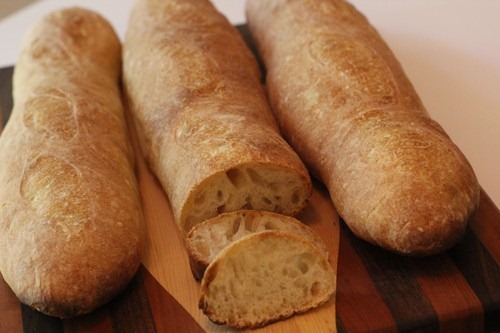
2nd Bake:
For the second batch, I used the same poolish (I had made a double batch), but reduced the amount of water and yeast in the final dough. I decided the extra hydration in the poolish needed to be adjusted in the final dough. I also baked the baguettes at a lower temperature (450 degrees). I was much more pleased with these baguettes. They were crispy on the outside and even crackled when they came out of the oven. The flavor was much better as well. I didn’t get the chance to try them until the next day but they tasted pretty good by themselves the next day. I also enjoyed them with jam, butter and egg salad.
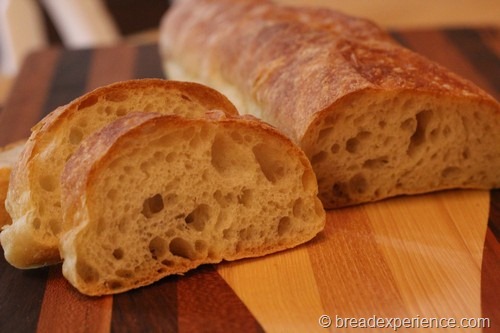
Poolish Baguettes Revisited
Adapted from Bread Science by Emily Buehler and Crust and Crumb by Peter Reinhart
Makes: 3 Baguettes
Ingredients:
Poolish
- 1 3/4 cup unbleached all-purpose flour
- 1 cup water
- pinch of instant yeast
Dough:
- 3 1/2 cups white bread flour
- All of the Poolish
- 3/4 cup water
- 1/2 teaspoon yeast
- 1 1/2 teaspoons salt
Directions:
1. Making the Poolish:
Combine all of the ingredients in a mixing bowl. Beat with a spoon or whisk about a minute, until the batter is mixed thoroughly and is pretty smooth. Cover the bowl with plastic wrap. Let it rest on the counter for 12 to 15 hours.
2. Mixing the Dough:
When the poolish is ready, combine the flour, water, and poolish in a large mixing bowl.
Add the yeast, then the salt and mix the ingredients together until the dough forms a ball. I used my hands to incorporate the yeast and then the salt thoroughly into the dough.
3: Kneading the Dough
Knead the dough on a floured surface for about 12 minutes. I only kneaded the dough for about 3-5 minutes. I used the turn and fold method during the bulk fermentation instead of the longer kneading time.
4. Bulk Fermentation
The dough should be shiny and smooth and little bit tacky, but not sticky. Place the dough in a greased bowl and let the dough proof for 2 hours. After an hour, fold the dough, re-shape it into a ball and place it back in the bowl. The dough should be about 1 1/2 times its original size after 2 hours.
5. Shaping the Baguettes
When the dough has risen, divide the dough into 3 equal pieces. Shape them into rough logs and place them on a lightly-floured counter. Mist them lightly with spray oil and cover them with plastic wrap. Let them rest for 30 minutes.
Shape the dough pieces into baguettes and place them on a floured couche. Refer to the Rosemary and Flax Baguettes post for step-by-step instructions on shaping baguettes.
6. Proofing the Loaves
Bring up the folds of the couche to support the shape of the loaves while proofing. I put books at either end to hold up the sides of the couche.
Spritz the loaves with spray oil and cover with plastic wrap. Let the loaves proof for 2 hours at room temperature, or until nearly doubled in size. If your house is warm, it might not take that long.
7. Prepare your oven for hearth baking
In the meantime, prepare your oven for hearth baking by placing a baking stone on the middle rack and an empty steam pan on the bottom rack. Preheat the oven to 450 degrees F.
8. Scoring the Loaves
Carefully and gently transfer the loaves from the baker’s couche to a baking sheet lined with parchment paper. I used a baker’s bench to assist with the process. Score the baguettes by making 1/2” cuts in the dough using a lame or serrated knife. I’m still getting the hang of this part.
9. Baking the Loaves
Pour 1 cups of hot water into the steam pan and immediately slide the loaves off of the baking sheet (parchment sheet an all) onto the baking stone. Steam the loaves again by spritzing the loaves and the oven walls with a spray bottle. Close the oven door and repeat the spraying process again after 2 minutes.
Bake the loaves for 20 to 30 minutes, or until they are golden brown in color. The formula in Crust and Crumb says to turn off the oven at this point and bake them an additional 5 to 10 minutes; however, this didn’t work for me. As I mentioned previously, the tips burned on the first batch, so for the 2nd batch, I only baked the loaves about 25 minutes at 450 degrees. The crust turned out great. It was crispy and crackly and wasn’t burnt at all.
10. Cooling and Slicing the Loaves
Transfer the loaves to wire racks and allow them to cool for at least 30 minutes before slicing and eating.

This bread has been YeastSpotted. Please visit Wild Yeast to view all of the lovely breads in the roundup.
I enjoyed these baguettes. I hope to enjoy more baguettes as I continue learning more about them and trying different techniques.
Happy Baking!
Cathy
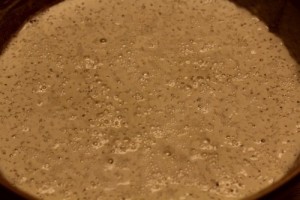

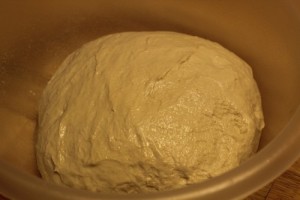
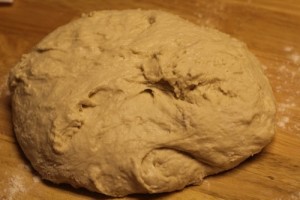
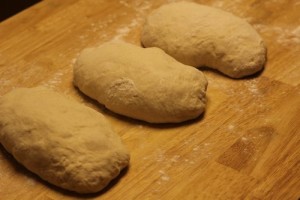

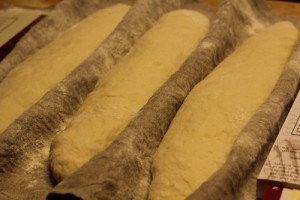
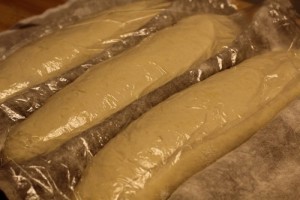
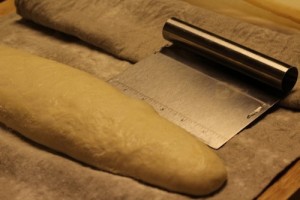
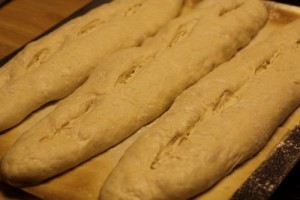
Rodman Rodriguez says
I think the measurements on your poolish (i.e., the ratio of flour to water) are off, no? Should it not be equal parts. I tried your ratios and a pretty solid looking dough resulted.
Cathy W. says
Hello Rodman, I’m sorry the baguettes didn’t turn out well for you.
I wanted to try a dough that wasn’t quite so wet. So for these poolish baguettes, I took a happy medium between the formula in the Bread Science book (100% white flour =1 3/4 cups or .42 lb white flour to 100% water = 7/8 cup or .42 lb water) and the formula Peter Reinhart uses in Crust & Crumb (100% flour = 4 cups or 18 ounces to 178% water = 4 cups or 32 ounces). I had to add more flour to the final dough as it was bit too hydrated (for me to work with).
Kristi says
I just mixed up the poolish and agree that it seems too dry (but then again, I’m a pharmacist, not a professional baker). But, I’ll have faith and proceed with the recipe as written 🙂 I’ll update with the final results.
Cathy W. says
Hi Kristi, do let me know how it turns out. The ratios worked for my purposes, but if the dough doesn’t seem hydrated enough for you, then you can add more water while you’re mixing the final dough. The dough should be tacky, not sticky. Unless of course, you prefer to work with a wetter dough.
Kristi says
So far so good. The dough was not nearly as hydrated as my usual baguette dough, but by the time I was ready to shape the loaves, it felt fine. I’m so excited to have them en couche so early in the day (I usually let my dough rise three times for baguettes, because otherwise the flavor is too one-dimensional for my taste). I’m hoping the poolish helps give me that developed flavor while allowing me to get these on the table on time.
Kristi says
Final results: the flavor was well-developed (fantastic!). However, my crumb wasn’t nearly as open as I’d like, probably (I’m guessing) because of the drier dough. I’m thinking next time I’ll increase the hydration (which I probably should have done anyway, given that I’m in cold and SUPER dry MT ) or fold several more times during the bulk fermentation (or both).
Your crumb looks great, though. Also, about 15 minutes into the baking time, I thought surely they would burn (they browned up quickly). But, they didn’t. The crust is fabulous 🙂
Cathy W. says
I’m so glad you liked the flavor and the crust. As for the crumb, I made these in June in hot and humid GA so that definitely makes a difference. Thanks for sharing your results! Happy Baking!